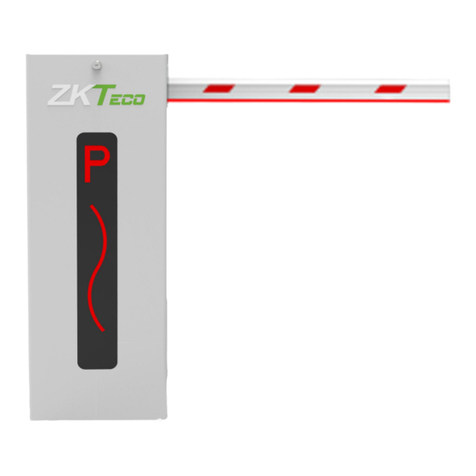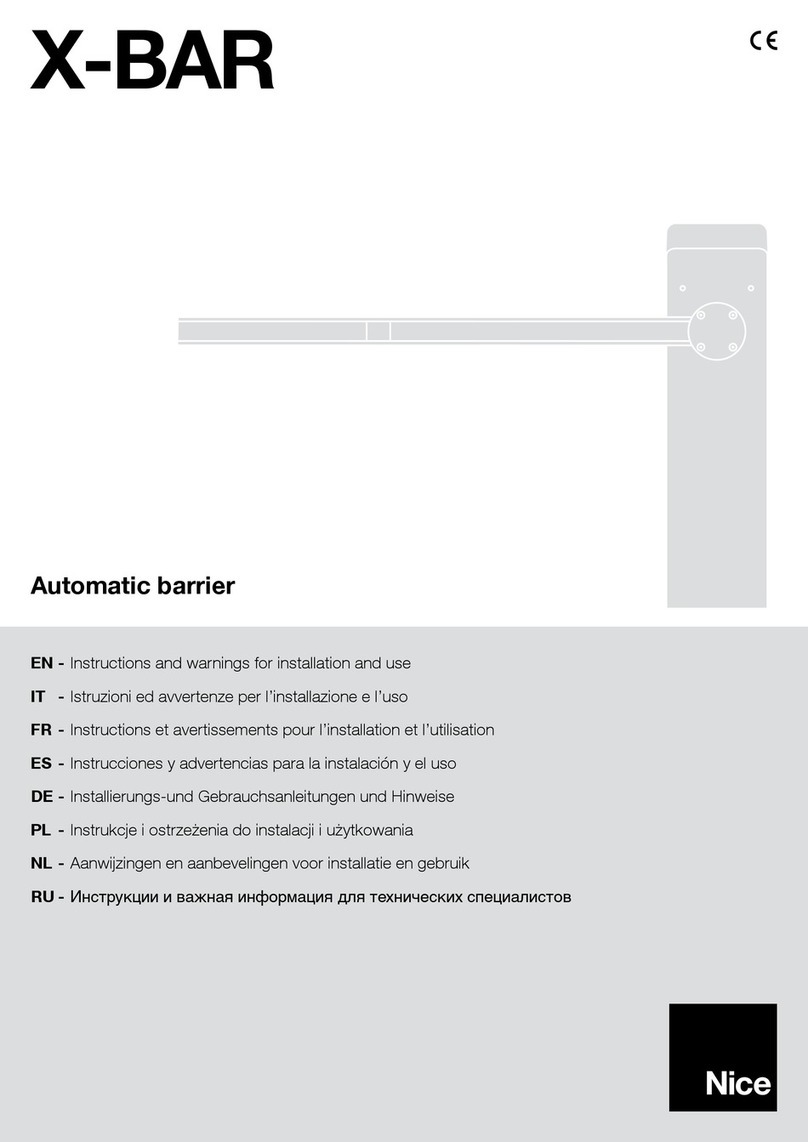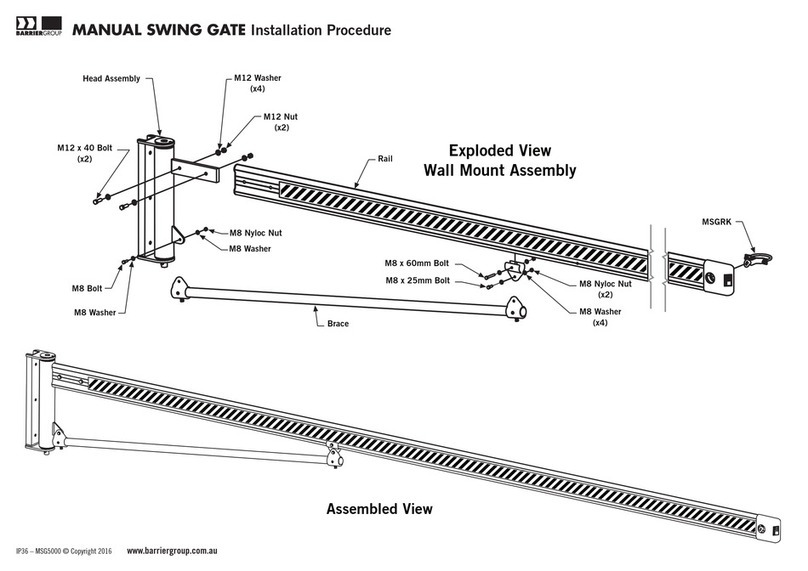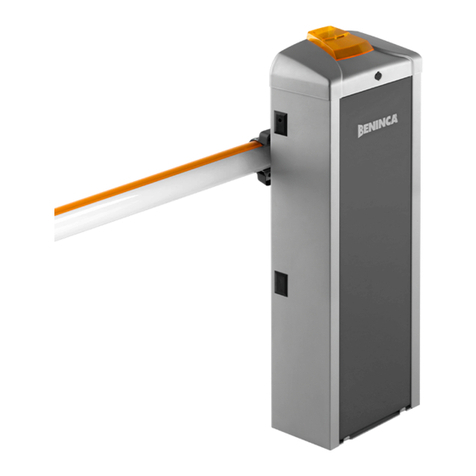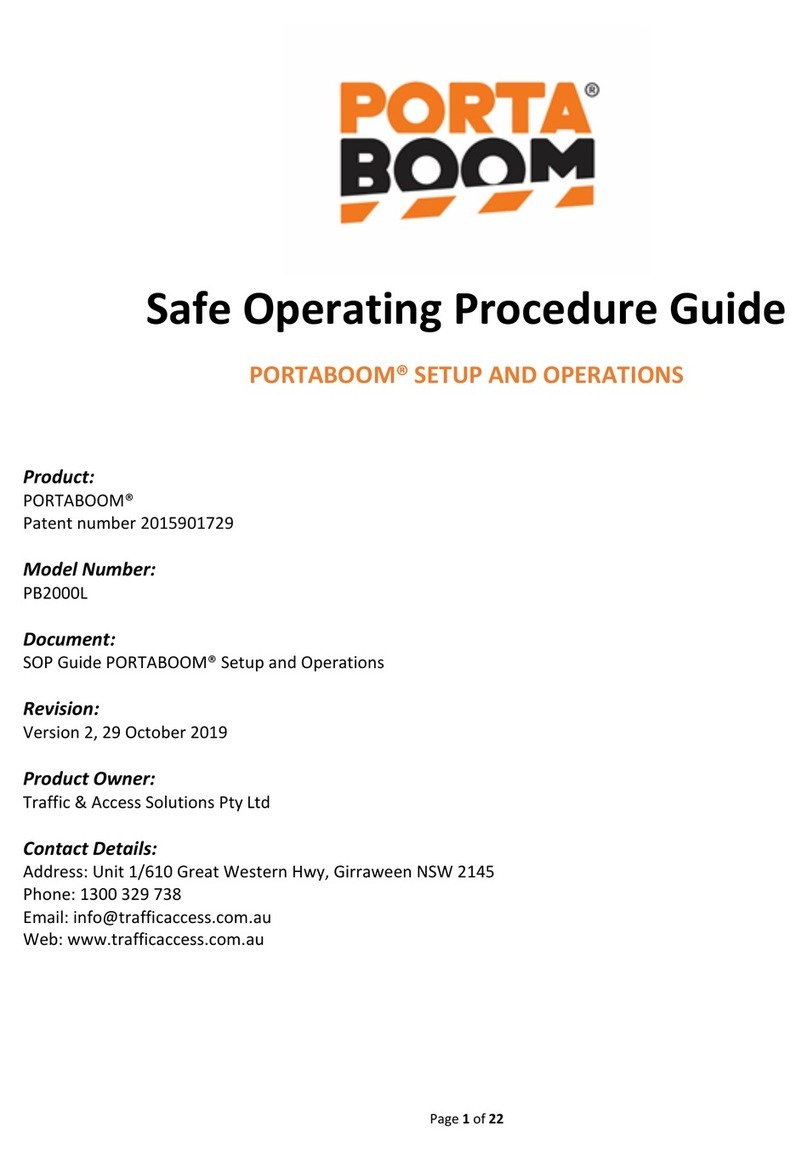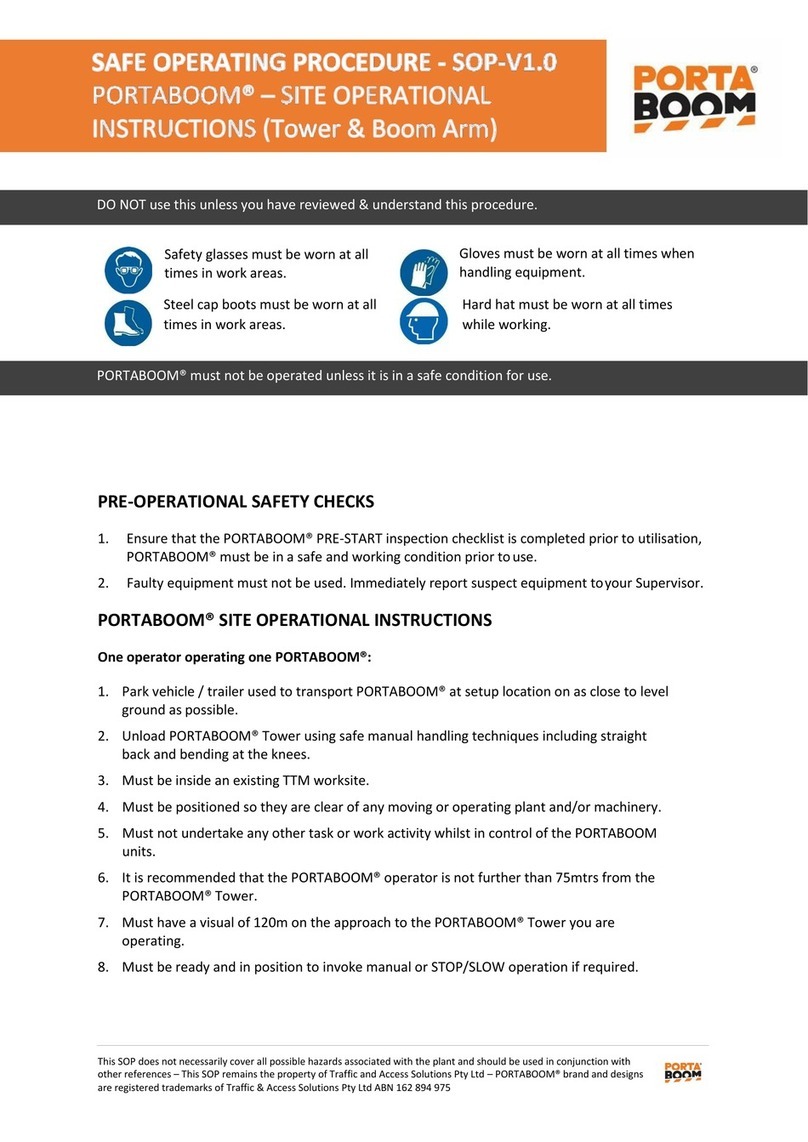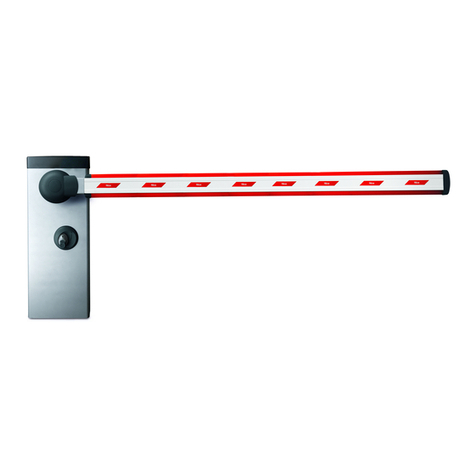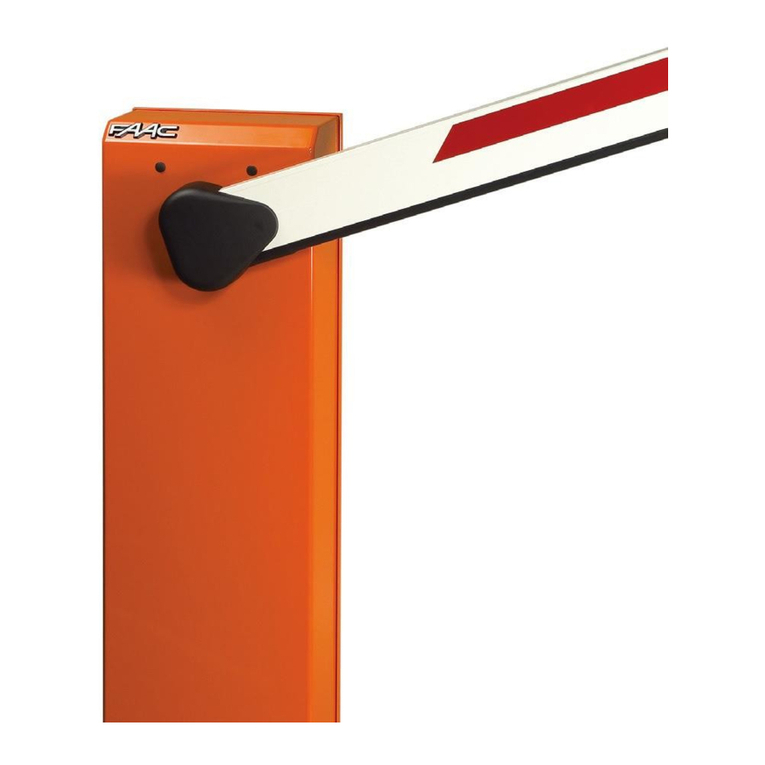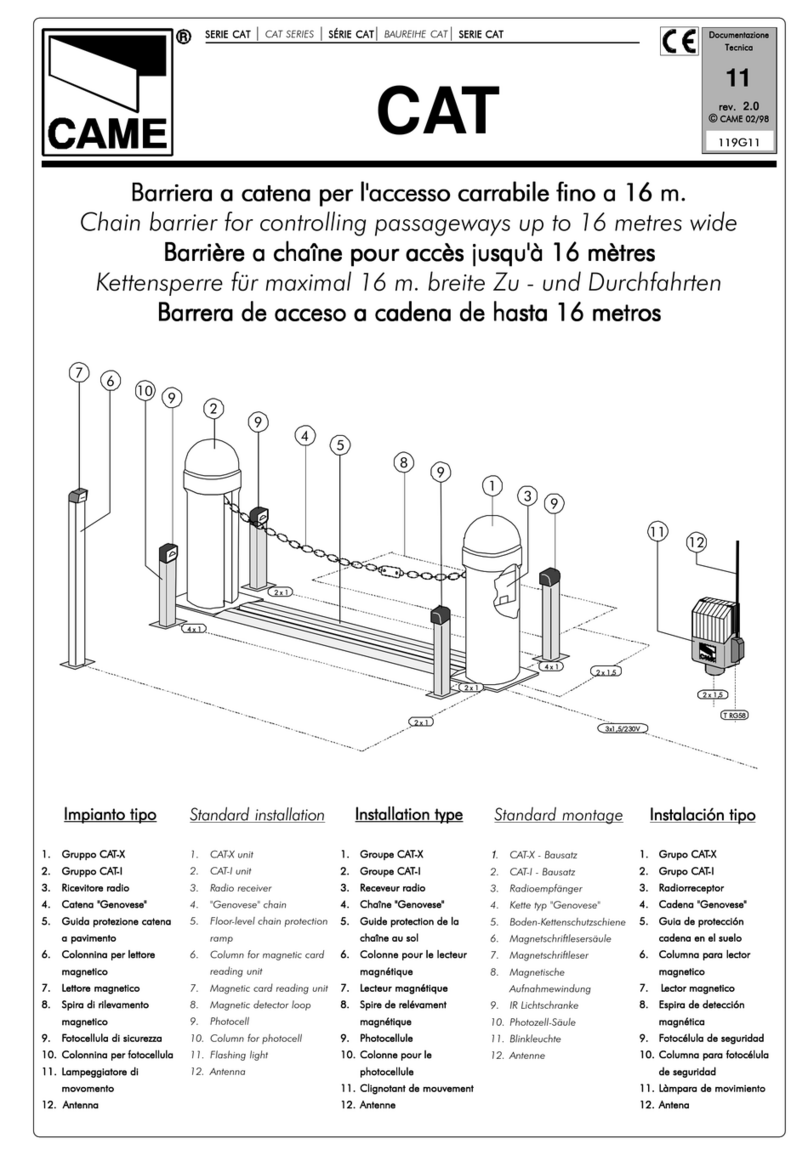GiBiDi DPT280 Manual

DPT280
UK
DPT280 Automatic bollards
FITTING, OPERATION AND
MAINTENANCE INSTRUCTIONS

DPT280
2
UK
1 - NOTES ON INSTALLATION
• Read carefully this manual before starting the installation and save it for future reference.
• Packaging materials (plastic, polystyrene, etc…) must be kept out of reach of children, because potentially
dangerous.
• This product have been designed and manufactured only for the use shown in this documentation. Any other use,
different from what expressly indicated could damage the integrity of the product and/or be potentially dangerous.
• Gi.Bi.Di. S.r.l. is not responsible for any damage caused by improper or different use than that for which the
automated system was intended.
• Do not install the device in an explosive area: the presence of gas or inflammable fumes is a serious danger for
safety.
• The installation must be performed in compliance with the law in force.
• In the extra-UE countries make also reference to the national law.
• Gi.Bi.Di. S.r.l. is not responsible for any non-compliance with the correct installation procedure of Gi.Bi.Di’s
products and accessories, as well as for any deformation that can occur while using.
• Before carrying out any work on the system, it is advisable to wea suitable personal protective equipment (e.g.
safety shoes, gloves, goggles, etc..).
• Before performing any operation on the installation, disconnect the main power supply.
• Place a 0.03A magnetothermic differential switch with an opening distance between contacts equal to or greater
than 3 mm to power the control unit.
• The main power supply line of the control unit must be directly connected to the main switch set inside the control
unit. Use approved anti-flame cable. The dimension of the main power supply line must be evaluated by the
installer according to the quantity of bollards (500W each bollard) and the distance from the output place, in order to
grant a proper supply (230V +/-10% per each moving bollard).
• Check that there is a suitable earthing and place/connect an earthing line to the terminal PE in the control unit.
• Every bollard is equipped with a safety pressure switch. The pressure switch operates the inversion every time it
detects a mass of at least 40 Kg on the head of the bollard while rising. In any case it is recommended to check the
activation level every six months.
• Each installation should have: a light signaling such as the flashing light integrated in the head of the bollard – an
acoustic buzzer that signals the bollard in movement – a traffic light (red – green) for each direction of transit – a
signpost for each direction of transit.
• For the maintenance use only original Gi.Bi.Di. spare parts.
WARNING: IMPORTANT SAFETY REGULATIONS.
It is important to follow these instructions carefully to ensure safety of persons and belongings. A faulty
installation or an incorrect operation of the product may cause serious damages to people and
belongings.
These instructions are for experts only, for someone who is able to complete fitting, operation and
maintenance in full safety conditions.

DPT280 3
UK
• Gi.Bi.Di. S.r.l is not responsible in terms of safety and good operation of Pilomat products, in case of use of non-
original Gi.Bi.Di’s spare parts.
• Do not perform any modification to the parts composing Gi.Bi.Di. system.
• The installer must provide to the customer all the information related to the manual lowering of the bollards in case
of need.
• Do not allow people and children to stop close to the bollards during operation.
• Keep radio transmitters and any other control devices out of the reach of children in order to avoid any unintentional
operating of the bollards.
• The transit is allowed only with the bollards completely down.
• The customer must avoid any repair or direct intervention and must address to qualify and authorized personnel.
• Do not throw the exhausted batteries in the garbage but dispose them in the proper containers to allow recycling.
• The bollards are packed on pallet. Use specific equipment or forklift for movement; handle with care.
• Gi.Bi.Di. bollards are manufactured with IP 66 or superior protection class and can be stocked everywhere, also
outdoor. It is however recommended to stocked the bollards in close or covered places.
• Gi.Bi.Di. bollards are designed to resist to transport and stocking effects in a range between -25°C and +55°C and
for a determined time (less than 24 hours) at +70°C.
• The bollards do not require any availability of spare parts: Gi.Bi.Di S.r.l warehouse can send any spare parts in
quick times.
• In case of maintenance or repair of the bollards, be sure to avoid any inappropriate rising control. To avoid
problems, disconnect the controls through the appropriate switch set in the control unit.
Any procedure not explicitly stated in these instructions is forbidden.
The trash container symbol shown on the product label, on the product or in the instructions indicates that the
product, at the end of its life, must be disposed separately from other waste products.
The end user must therefore bring the item to an authorised electronic waste disposal centre, or return it to the dealer
when new equivalent product is purchased.
Proper separate collection for recycling, treatment or compatible environmental disposal contributes to avoid
negative effects on the environment and health, moreover it favours reuse and recycling of the materials the product
is made of.
Improper disposal of the product is subject to fines.
2 - DISPOSAL

4
3 - BOLLARD DATASHEET
Bollard DPT280
Cylinder material
S235JR normal steel
X5CrNi18-10 (AISI 304) stainless steel
X5CrNiMo17-12-2 (AISI 316) stainless steel
Cylinder diameter 275 mm
Cylinder height 800 mm
Normal steel cylinder thickness 6 mm
Stainless steel cylinder thickness AISI 304: 6 mm - AISI 316: 4 mm
Normal steel cylinder finish
Anti-corrosion treatment
(optional: other RAL colour on request)
Grey anthracite standard painting
Stainless steel cylinder finish Grey anthracite standard painting or brushed
Other cylinder finish Ribs on cylinder’s surface (optional)
Reflecting adhesive strip Standard - height 55 mm
Rising speed 17 cm/s
Lowering speed 32 cm/s
Manual emergency lowering Standard
(optional: automatic lowering if power failed)
Safety reversal pressure switch Standard
Connection line to control unit Standard 10 m
(max. lenght 80 m - with heating resistance)max. 50 m
Hydraulic pump for movement Built-in into the bollard
Hydraulic pump absorption 230V +/- 10% - 2.2A (max. 3.4A)
Hydraulic pump thermal protection Standard
intervention threshold 120°C - automatic recovery 80°C
Protection class IP67
Type of use Intensive - 2,000 cycles/day
Life average 3,000,000 cycles
Impact resistance (without deformation) 40,000 J
Breakout resistance 250,000 J
Permitted ambient temperature from -40°C to +70°C
(for temp. lower than -10°C use the heating resistance)
Relative humidity function range from 10% to 80%
Max. altitude in operation 1,500 m above s.l.
Max. airborne sound emission in operation 60 dB
Weight included 10m connection cable
and foundation box 185 Kg
Foundation box weight 47 Kg
DPT280
UK

5
4 - BOLLARD COMPONENTS
LOWER
LIMIT SWITCH
LOWER
SUPPORT
BASE
REFLECTING
STRIP
FLASHING LIGHT
HEAD
DPT280
560
560
40
150
800
275
1140
MOVING
CYLINDER
FRAME
PASSIVE BOX
PISTON
HYDRAULIC PUMP
SOLENOID VALVE
RISING SIDEBLOCK
UK

6
5 - INSTALLATION PROCEDURE
140 mm200 mm300 mm
1430 mm
1000 mm
1000 mm
Walking level
10 mm
SENSO DI TRAFFICO
TRAFFIC WAY
ø 50 mm
PIC. 1
PIC. 2
PIC. 3
PIC. 5 PIC. 4
DPT280
UK

7
5 - INSTALLATION PROCEDURE
PIC. 6
FOUNDATION
BRACKET
CONTROL
UNIT
JUNCTION BOX
400 x 400 mm
FLEXIBLE SHEATH
diameter 50 mm
max. 1600 mmmax. 1600 mm
DPT280
UK

8
WATER
DRAINAGE
TRAFFIC WAY
BOLLARD
COUNTERFRAME
ANCHORING
PLATE
50 mm SHEATH
FOR ELECTRICAL
CABLES
WALKING
LEVEL
ROAD
SURFACE
ADDITIONAL
CONCRETE
CASTING
SUPPORTING
SLAB
M8 CHEMICAL
ANCHORS
M16
CHEMICAL
ANCHORS
WATERPROOF PIT
IN STAINLESS STEEL
WATERPROOFING
SHEATH
10 mm
50 mm 600 mm
275 mm
450 mm
500 mm
925 mm
AB
700 mm
700 mm
450 mm
450 mm
“A” dimension is the sum of the different thicknesses of which the slab is made of.
PIC. 7
5 - INSTALLATION PROCEDURE
DPT280
UK

9
PIC. 8
PIC. 10 PIC. 11
PIC. 9
M16
M16
5 - INSTALLATION PROCEDURE
DPT280
UK

10
5 - INSTALLATION PROCEDURE
min. 25 cm
5,5 cm
9 cm
15 cm
~15 cm
~15 cm
PIC. 16
PIC. 15
PIC. 17
Control
Unit
DPT280
95 cm
95 cm
95 cm
95 cm
PIC. 12
300 cm
70 cm max. 160 cm 70 cm
90 cm
90 cm
PIC. 13
280 cm 200 cm
80 cm
80 cm
PIC. 14
UK

11
5.1 - INSPECTION AND PREPARATION
5.2 - CHECKING GROUND PERMEABILITY
Premise
The bollards and the corresponding foundation boxes may be delivered pre-assembled.
The bollards, control unit and required accessories are packaged on pallet.
Use appropriate lifting equipment or a forklift for transport .
Checking the subsurface
Before inserting the foundation box, make sure that the location where the bollard is to be fitted meetshe following
requirement:
1. Water-bearing layers must not be present in the subsurface.
2. Lines or electrical cables must be not present.
3. A ground connection system corresponding with the directives must be available.
If the bollard is positioned on a gradient, the slope can cause rainwater to penetrate the foundation box. You must
provide a drainage channel with a cover grille in front of the bollard and in its immediate vicinity to prevent rainwater
from penetrating the system.
An important factor when inserting the bollard is prior assessment of the ground permeability to drain rainwater.
Make sure that the ground permeability in the fitting area meets the following requirements in advance:
• Perform a test to check the ground permeability before inserting the foundation box.
• Pour approx. 40 litres of water per m2 into the pit.
• Check whether the water seeps into the ground within approx. 30 minutes.
If the test is negative:
• Drain off the rainwater via a Ø 50 mm drainage pipe.
• Connect the drainage pipe to the sewer system.
Alternatively, the drainage pipe can be connected to a rainwater collection tank under the foundation box equipped
with an immersion pump and a float for automatic drainage. Or connect the drainage pipe to the sewer system.
DPT280
UK

12
1. Dig a 1000 x 1000 mm pit with a depth of 1430mm (PIC. 1). If the foundation box is equipped with immersion
pump, dig a pit with a depth of 1730 mm (see drawings at page 6) .
2. Ensure that the ground for inserting a bollard has good permeability (Note section at chpt. 5.2).
NOTE: read the paragraph "inspection and preparation", chpt. 5.1.
3. Fill with gravel up to approx. 300 mm high (grain size 8 – 20 mm). Compact the gravel to prevent the bollard from
settling later on (PIC. 2).
4. Fix the foundation anchors properly to the foundation box
5. Place the foundation box in the pit, together with counterframe and foundation anchor:
• align the foundation box in accordance with the passage direction, as stated on the frame (PIC. 5).
• position the foundation box exactly vertical .
(PICs. 2 and 4).
(PIC. 2)
• in order to position the foundation box at the right height, backfill the foundation box with gravel or remove
gravel. Make sure that the frame is 10 mm higher than the road. This will restrict rainwater penetration into
the foundation box (PIC. 3).
• when fitting several foundation boxes, ensure that they are all turned in the same direction and precisely aligned
(PIC. 6).
6. Fill the space around the foundation box with gravel up to approx. 200 mm to avoid any obstruction of the drainage
holes, placed at the bottom of the pit, during the concrete casting .
7. Lay a flexible ø 50 mm tube from each foundation box to carry the connecting cable from the bollard to the control
unit (PICs 2 and 4).
WARNING! If the foundation boxes and the control unit are more than 10 m apart, please order the bollard
with extended connecting cable (standard length 10 m – optional up to max. 80 m ).
8. When fitting foundation boxes with immersion pump, connect a flexible ø 25 mm tube from each foundation box
to the sewer system or similar.
9. Cast the concrete up to approx. 100 mm under the ground surface (the height depends on the type of road
surface).
NOTE: cast the concrete in two working steps to prevent the liquid concrete from pushing the foundation box up.
Compact the concrete.
10. When using accessories (e.g. induction loops, traffic lights, key switch post), lay a flexible ø 50mm tube from
the control unit to the corresponding fitting position of the accessory.
11. Apply the road surface once the concrete has dried.
All the pipelines shall be laid in full compliance with the regulations in force.
5.3 - DIGGING THE PIT
DPT280
UK

13
5.4 - INSERTING THE BOLLARD ON SLAB
5.5 - INSERTING THE BOLLARD
In case of laying on slab (PIC. 7) it is necessary to purchase the specific "kit for installation on slab". The instructions
are as follows:
1. Mark the laying point of each bollard, then remove the road surface/concrete casting for about mm 1000 x 1000.
Remove the waterproofing sheath in the middle of the laying point for about mm 500 x 500; take into consideration
the consecutive restoration .
2. At the moment of purchasing, communicate the thickness of the slab in order to let the manufacturer produce
a stainless steel waterproof pit of a suitable length ref. A and B .
3. In the center of the laying point remove the slab by drilling a through hole of about mm 450 x 450 mm .
4. Place the counterframes equipped with anchoring plate in the center of the through hole. Secure it by means of
12 M16 chemical anchors (supplied by the building contractor) complete with supplementary nuts for the proper
leveling of the counterframe/anchoring plate with respect to the walking level (to limit rainwater infiltrations into
the pit, arrange the counterframe approx. 10 mm higher than the walking level ).
5. Restore the waterproofing sheath, the additional concrete casting and the road surface.
6. By means of 8 M8 chemical anchors (supplied by the contractor), secure the stainless steel waterproof pits to the
ceiling of the basement).
7. Lay the pipes for the electrical cables from the bollards to the control unit.
8. Lay the pipes for rainwater drainage from the waterproof pits to the drainage area.
9. Lay the additional pipes from the control unit to the installation point of the accessories (i.e. inductive loops, traffic
lights, consolle, etc.). Prearrange the electrical connection and the earthing to the control unit.
(PIC. 7, )
All the pipelines shall be laid in full compliance with the regulations in force.
1. Keep the bollard ready in the immediate vicinity of the foundation box.
2. Completely extend the cables on the ground to avoid possibile twisting.
3. Lay the connecting cable for each bollard through the tube to the control unit .
4. Lay the connecting cable in the foundation box through the strain relief provided (PIC. 8).
ATTENTION! The function of the bollard may be impaired if the connecting cable is attached at a different point.
5. Screw the four M16 eye bolts (not included in the bollard scope of delivery) into the prepared threaded holes
(PIC. 9).
6. Fasten the strap, chains etc. onto the eye bolts and raise the bollard. Please observe the min. carrying capacity!
Gently place the bollard in the foundation box o (PIC. 10).
ATTENTION! The function of the bollard may be impaired if the connecting cable is twisted.
7. While inserting the bollard into foundation box, avoid tight winding when laying the connecting cable in the
foundation box. Make sure that the lines are not clamped (PIC. 11).
ATTENTION! While inserting the bollard into the foundation box, make sure not to twist the cables nor to crush
them.
DPT280
UK

14
5.6 - LAYING THE INDUCTION LOOPS
If the system is used in the automatic operating mode (extension of bollard after a vehicle has driven
through), induction loops must be laid to detect metal masses (vehicles).
Induction loops are suitable for two different applications:
• "Limited" protection of the bollards (PIC 12 - PIC. 13). In this case a single inductive loop is installed around
the bollards, it avoids the raising in case a vehicle is over the bollards or in the immediate surroundings.
• "Extended" protection of the bollards (PIC. 14). Two induction loops, one before and one after the bollards, are laid
for added protection. A passing vehicle is identified approx. 3000 mm in front of the bollards and detected
to approx. 3000 mm behind the bollards. This allows the following vehicles to be identified in advance and thus
to prevent possible collisions.
Notes on laying the induction loops:
1. Standard induction loops are 9.60 m long (1800 × 3000 mm). Other lengths are also available.
2. Induction loops consist of a special cable with approx. Ø 9 mm. These are suitable for direct laying in the ground
without sheathing or other protective equipment.
3. Ensure that there is no reinforcing steel mesh when laying the induction loop. If a reinforcing steel mesh is present,
remove it up to approx. 25 cm above the circumference of the induction loop (PIC. 16).
4. Make sure that the corners are rounded when laying the induction loop” (PIC. 16 - PIC. 17).
5. Lay the induction loop 7 cm beneath the ground surface. In case of paving stones with a thickness of at least
10 cm, the material must be adjusted to permit laying at the specified depth. Alternatively, you can lay the
induction loop between paving stones in a diagonal join.
6. Induction loops are equipped with a connection box (PIC. 15) to which the connecting cable for signa transmission
to the control is connected. The connecting cable consists of a strong, special cable with a standard length
of 15 m. (you can also order induction loops with a longer connecting cable ).
7. You can also use induction loops to detect an exiting vehicle and for automatic requests to lower the bollard.
DPT280
8. Remove the eye bolts as soon as the bollard is positioned. Screw the bollard tight with the nuts supplied then apply
the plastic caps supplied on the top of the screws.
9. Carry out the basic electrical connections of the control unit as indicated in chpt. 6.2.
WARNING! When connecting the bollard to the control unit carefully read the wiring diagrams contained in the
scope of delivery.
10. The control unit, configured according to the customer's needs as described in the order sheet,
is supplied with all the necessary wiring diagrams, including the electrical connections of the bollard.
UK

15
In order to connect all the electrical devices, a passive box with six connections is installed on the bollard frame.
The wires of these devices are marked out by different colours.
For the correspondence see the wiring diagram (PIC. 19 ).
6 - ELECTRICAL CONNECTIONS
6.1 - BOLLARD WIRING
No.
1
2
3
4
5
6
Colour
BLUE
GREY
YELLOW
BLACK
WHITE
RED
Device
FLASHING LIGHT / BUZZER (opzional)
SOLENOID VALVE FOR LOWERING*
SAFETY PRESSURE SWITCH
LIMIT SWITCH BOLLARD DOWN
LIMIT SWITCH BOLLARD UP (optional)
HEATING RESISTANCE (optional)
* Standard solenoid valve: N.C. = in absence of power supply the bollard remains in up position.
Optional solenoid valve: N.O. = (gravity effect).in absence of power supply the bollard automatically lowers
White
Yellow
Blue
Red
Black
Grey
PIC. 18
DPT280
UK

16
6.1 - BOLLARD WIRING
Shield = PE
*interchange is possible
*Brown
*Black
Yellow
Blue
Purple = Heating resistance 80W
Blue = 0v Buzzer
Grey = Sensor for detecting bollard up position ( c )
Green = Pressure sensor
Black = 0v LED (ashing light)
Purple = Heating resistance 80W
Red = Solenoid valve 24Vdc
Brown = DOWN position
Black = UP position
Yellow/Green = Grounding
Grey = Common for motor
Red = + 24V common
White = Sensor for detecting bollard downposition
Grey = Sensor for detecting bollard up position (nc)
Red = Solenoid valve 24Vdc
1
3
2
4
2
4
2
4
4
2
1
1
2
4
2
6 BROWN5 WHITE
3 YELLOW
1 BLUE 2 GREY
Hydraulicl unit
4 BLACK
M12
1
3
4
2
1
3
4
2
1
3
4
2
1
3
4
2
2
1
3
4
2
1
3
4
M11 M9 M4
M14 M6
113 4
15 14
16 10
x11 2
x9
+
M19
M
M20
M1M3
M13 M5 +
7 8
6
4
13 24
M17M18 M10 M2
5 WHITE Sensor for detecting
bollard up position
3 YELLOW Safety pressure
switch
1 BLUE Flashing light
and buzzer
6 RED Heating resistance
4 BLACK Sensor for detecting
bollard down position
2 GREY Lowering solenoid
valve
J12T6B5-PG135-WL-PIL
PASSIVE BOX
PIC. 19
DPT280
This diagram is for illustration purposes only. When connecting the bollard to the control unit carefully read the wiring diagrams contained in the scope of delivery.
UK

17
The control is supplied in metal housing (protection category IP56 or IP66) for wall fitting as standard.
Fit the control preferably in:
• a covered place,
• a place protected from poor weather conditions,
• a place protected from direct sunlight.
The size of the housing depends on the system configuration (see chpt. 6.4 "Housing size").
Further housings for the control unit are available on request, e.g. rectangular switch cabinets for floor fitting, key
switch posts with 275mm with lockable maintenance flap and 1-sided traffic lights, 2-sided traffic lights and /or
control elements.
Ø
Note 1: the dimensions stated in the table relate to the control with standard configurations. The use of optional accessories such as a timer or a
transformer for the heating resistances etc. may require larger dimensions.
Note 2: please Contact your specialist dealer to find out the control dimensions for more than 5 bollards (e.g.control for 8 bollards).
6.2 - CONTROL UNIT
6.3 - CONTROL UNIT DATASHEET
6.4 - HOUSING DIMENSIONS
Circuit board
Standard housing
Protection category
Supply
Control unit protection
Service transformer
Permitted ambient temperature
Relative humidity function range
Max. no. of bollards that can be connected
(all bollards connected to one control always move simultaneously.
Controlling individual bollards is not possible)
with microprocessore with specific control program
for wall fitting
IP66
230V +/- 10% - 50/60 Hz
Thermal-magnetic circuit breaker termico 1P + N - 6kA
24V - Standard power 100 VA
from -15°C toa +60°C
from 10% to 80%
No restrictions.
Each control contains: 1 master circuit board onto which
the 1st bollard is connected, as many slave circuit boards
as there are additional bollards available
Configuration
SP1 - system with 1 bollard
SP2 - system with 2 bollards
SP3 - system with 3 bollards
SP4 - system with 4 bollards
SP5 - system with 5 bollards
Material IP class Dimensions
ABS IP 56 400 x 300 x h. 130 mm
Steel IP 66 500 x 400 x h. 200 mm
Steel IP 66 600 x 400 x h. 200 mm
Steel IP 66 700 x 500 x h. 200 mm
Steel IP 66 700 x 500 x h. 200 mm
DPT280
UK

18
6.5 - EXAMPLE OF CONTROL UNIT
TRANFORMER
100VA 230V 0-24V
AUTOMATIC SWITCH
1P + N 6kA C216A
UNIPOLAR EARTHING
TERMINAL BOARD -
2
16 mm
METALLIC BOX
IP66 - mm 600 x 500 x 200
MASTER CIRCUIT
SLAVE CIRCUITS
EXAMPLE OF CONTROL UNIT FOR 3 GI.BI.DI. DPT280 BOLLARDS
1. Lay the wall box.
2. Pull the main electrical supply line (230 Vac) into the control. Connect the line directly to the main switch.*
3. Pull the ground connection line into the control. Connect the line directly to the PE terminal.
4. Pull the connecting cable for each bollard into the control. Connect the lines as follows: 1st bollard to the master
circuit board; each additional bollard to the corresponding slave circuit board..
5. Pull the additional lines for the accessories into the control. Connect the lines to the master circuit board according
to the connection tables.
6. Before running a functional test consult the instructions related to the electric connections provided with the
system.
* The main power supply line of the control unit must be directly connected to the main switch set inside the control
unit. Installation of the main supply line depends on the number of bollards (500W each bollard) and the distance
of the bollards to the control unit to ensure sufficient supply (230V/400V +/- 10% on the moving bollard).
6.6 - WIRING THE CONTROL UNIT
PIC. 20
DPT280
UK

19
7 - CONTROL UNIT
7.1 - MASTER AND SLAVE CIRCUIT
7.2 - PROTECTION FUSES MASTER - SLAVE
7.3 - MASTER PUSH BUTTONS
Button
RESET
START
PROG
SERVICE
Function
Performs program recovery (in case of blocking)
Starts extending and lowering (depending on the setting of DIP Switch)
Programming the system adjustment parameters
Enter the maintenance mode
Master Slave
F1
F2
F3
F5 F1
F6
F7 F2
Typology Connected components
2AT 230V - 24 VAC power supply unit supply fuse
1AT Timer supply fuse
2AT Traffic light supply fuse
5AT Supply to accessories connected to terminals 1-2-3 / 31-32-33
1AT
2AT
Safety devices supply fuse
Logic fuse
F5 5AT
F3 2AT
PIL16 MASTER CIRCUIT
PIL16 SLAVE CIRCUIT
F2 1AT
F7 2AT
F1 2AT
F6 1AT
F1 5AT
F2 2AT
PIC. 21
DPT280
UK

20
7.4 - MASTER CIRCUIT BOARD CONNECTIONS
Terminal Contact
1-2-3
31-32-33
46-47-48
51-52
34-39
40-41-42
43-44-45
49-50
4
5
53
54
55-59
6-7-8
9-10
15
16
28-30
29-30
13
17
11-12
14
24-25
26-27
60-61
62-63
64-65
65-66
67-68-69
20-21
22-23
N.C.
N.O.
N.O.
N.O.
N.O.
N.C.
N.O.
N.O.
N.C.
LEDConnected device
Through terminals 31-32-33. Protected by F5 fuse
Through terminals 1-2-3. Protected by F5 fuse
Outlet for traffic light signal (neutral exchange)
Inlet for 230V power supply
Inlet/outlet for transformer connection
Outlet 230V (40= red - 41= green - 42= common) connection to traffic light
Outlet 230V connection to traffic light (40= red - 41= green - 42= common)
Inlet for breaking glass button - emergency automatic lowering
(only for bollards equipped with automatic lowering - NO 230V)
Grounding for hydraulic pump motor
None
None
Inlet for grounding
Inlet/outlet connection to yearly/weekly progremmer
Outlet 230V power supply for hydraulic pump (common terminal 8)
L7
L3
L4
L1
L2
L13
L13
LIN
L5
L12
L11
L14
Outlet 24V power supply for solenoid valve
Outlet 24V power supply for acoustic buzzer
Outlet 24V power supply for flashing light
Outlet 24V power supply for radio receiver
Outlet 12V power supply for radio receiver
Common: Lower limit switch - Acoustic buzzer - Flashing light
Common: Lower limit switch - Acoustic buzzer - Flashing light
Inlet for pressure switch or upper limit switch
Inlet for lower limit switch
Start command inlet (lowering control or step/step)
Inlet command from radio receiver (lowering control or step/step)
Inlet for future functions or customizations
Outlet for future functions or customizations
Inlet for lowering command (common terminal 65)
Inlet for rising command (common terminal 65)
CAN-BUS connection slave circuits (67= CANH - 68= CANL - 69= 0V)
Inlet for safety devices (example: inductive loops detector)
Outlet 24V power supply for safety devices (example: inductive loops detector)
DPT280
UK
Table of contents
Popular Automatic Barrier manuals by other brands

ZKTeco
ZKTeco PB3000 Series installation guide
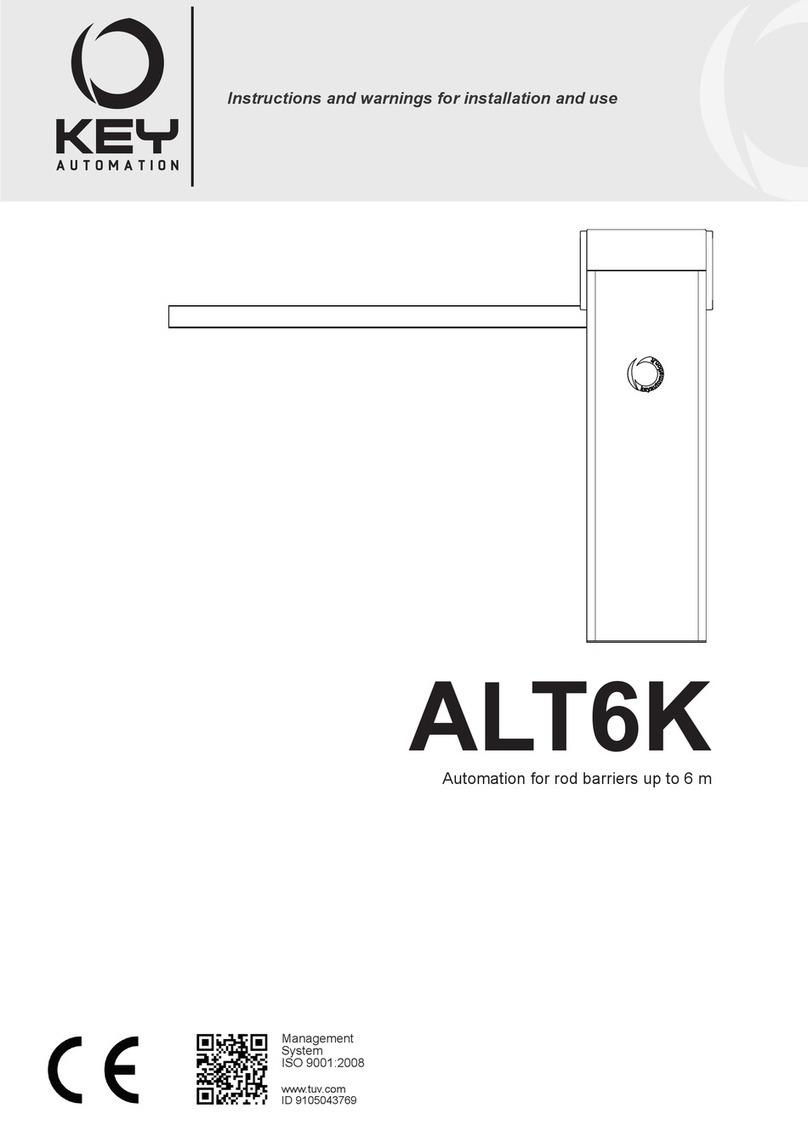
Keyautomation
Keyautomation ALT6K Series Instructions and warnings for installation and use
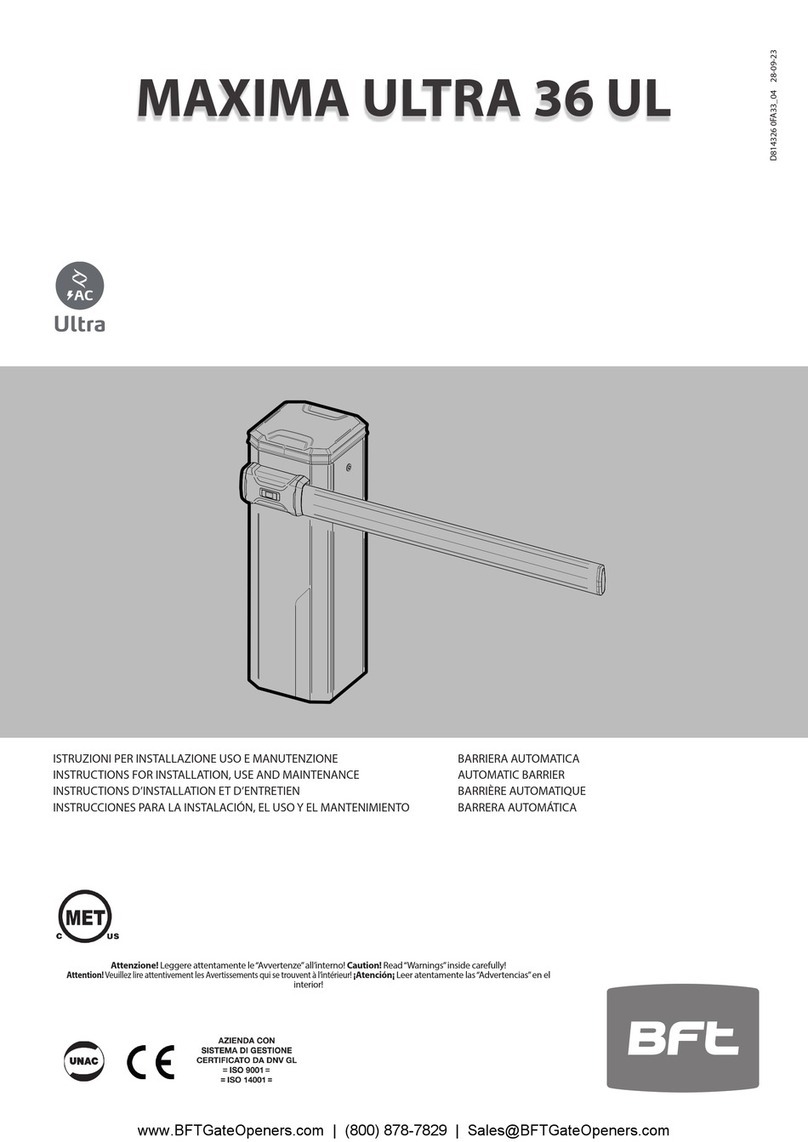
BFT
BFT MAXIMA ULTRA 36 UL Instructions for installation, use and maintenance
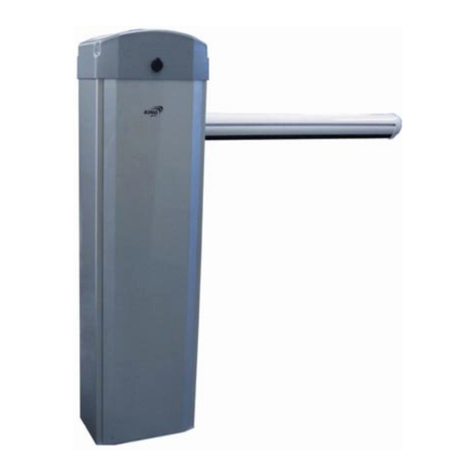
King gates
King gates Open 424 Manual instruction
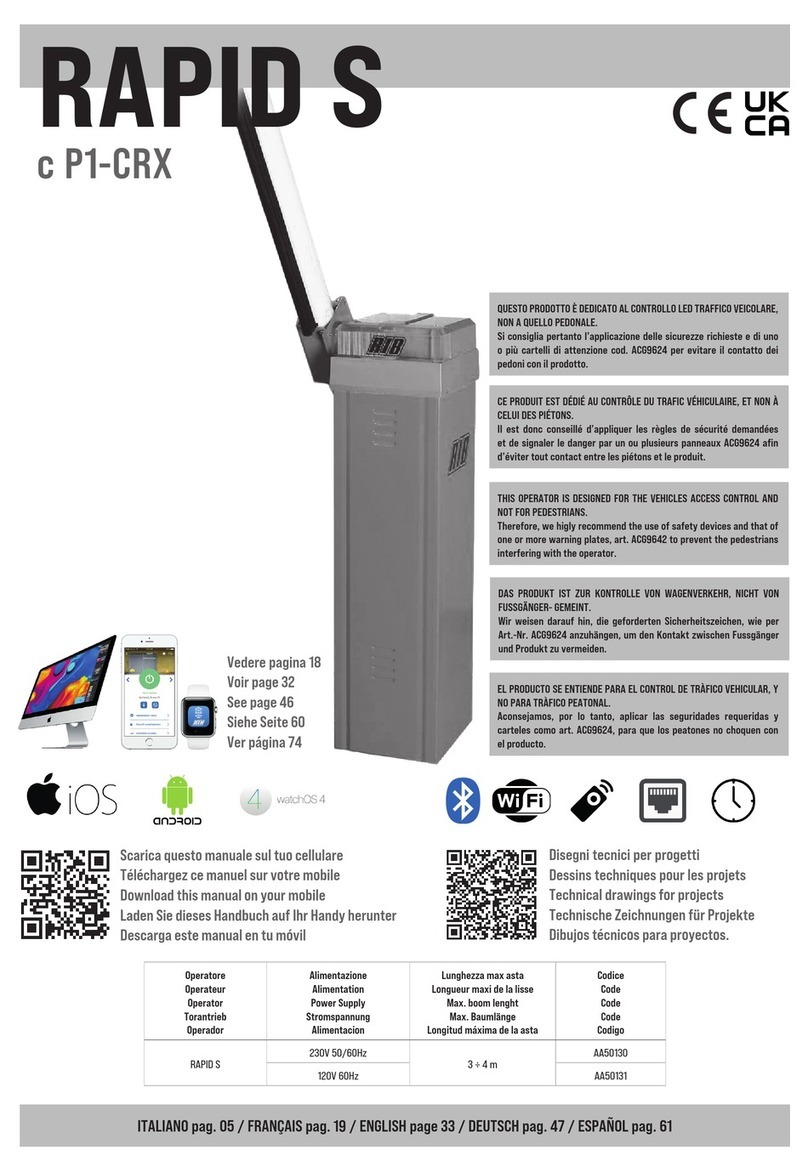
RIB
RIB RAPID S P1-CRX manual
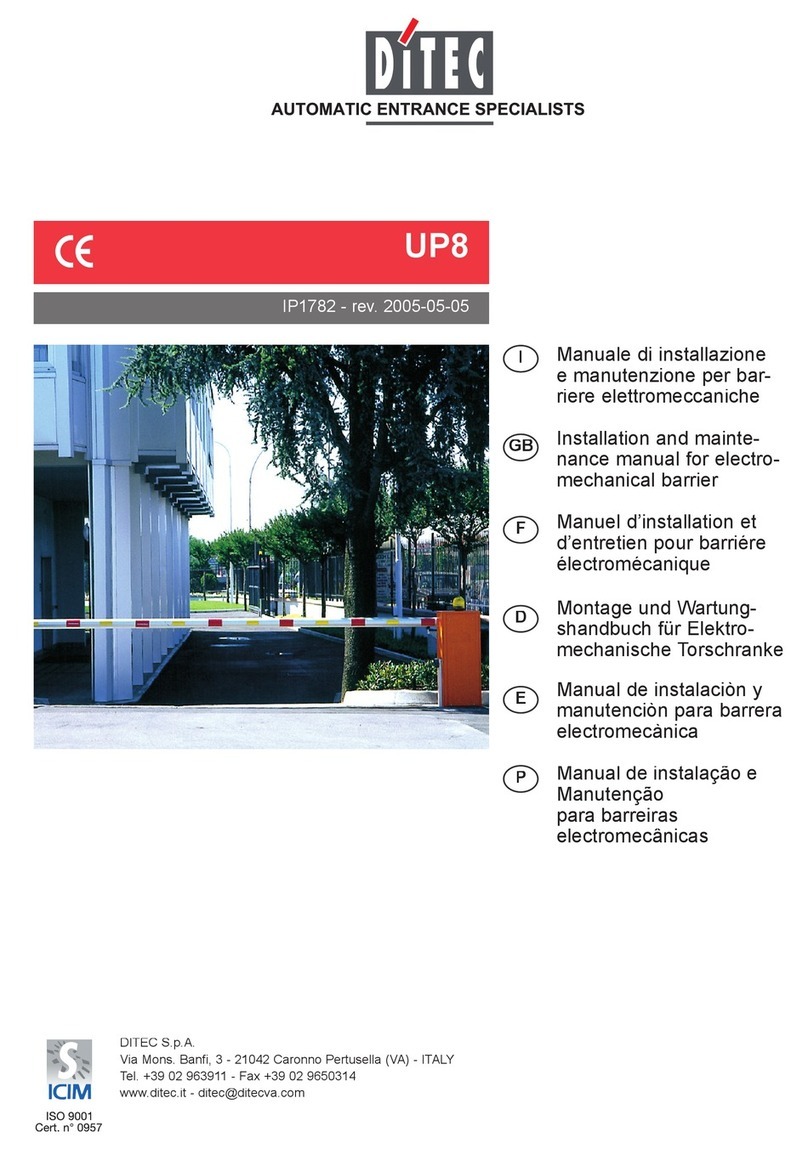
DITEC
DITEC UP8 Series Installation and maintenance manual
